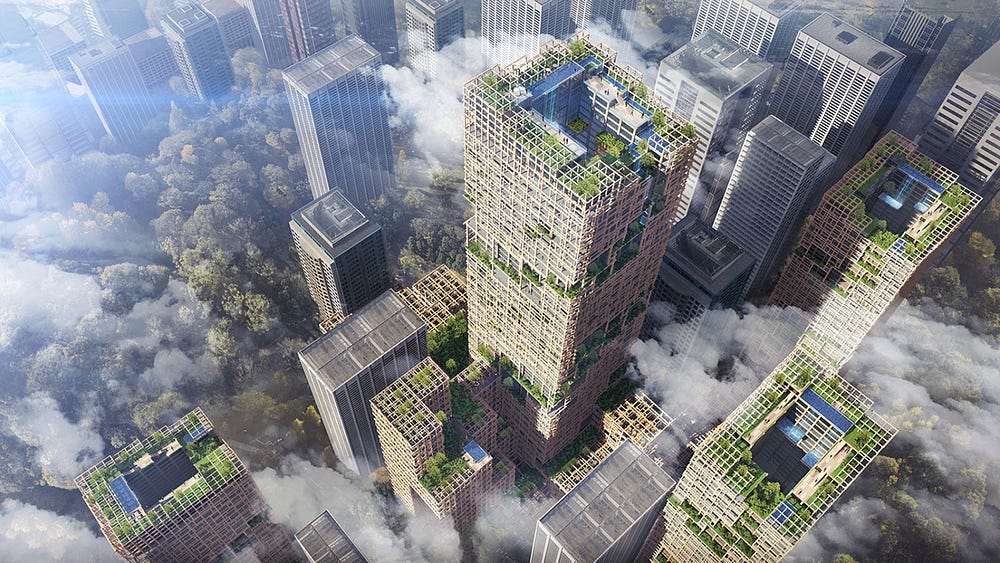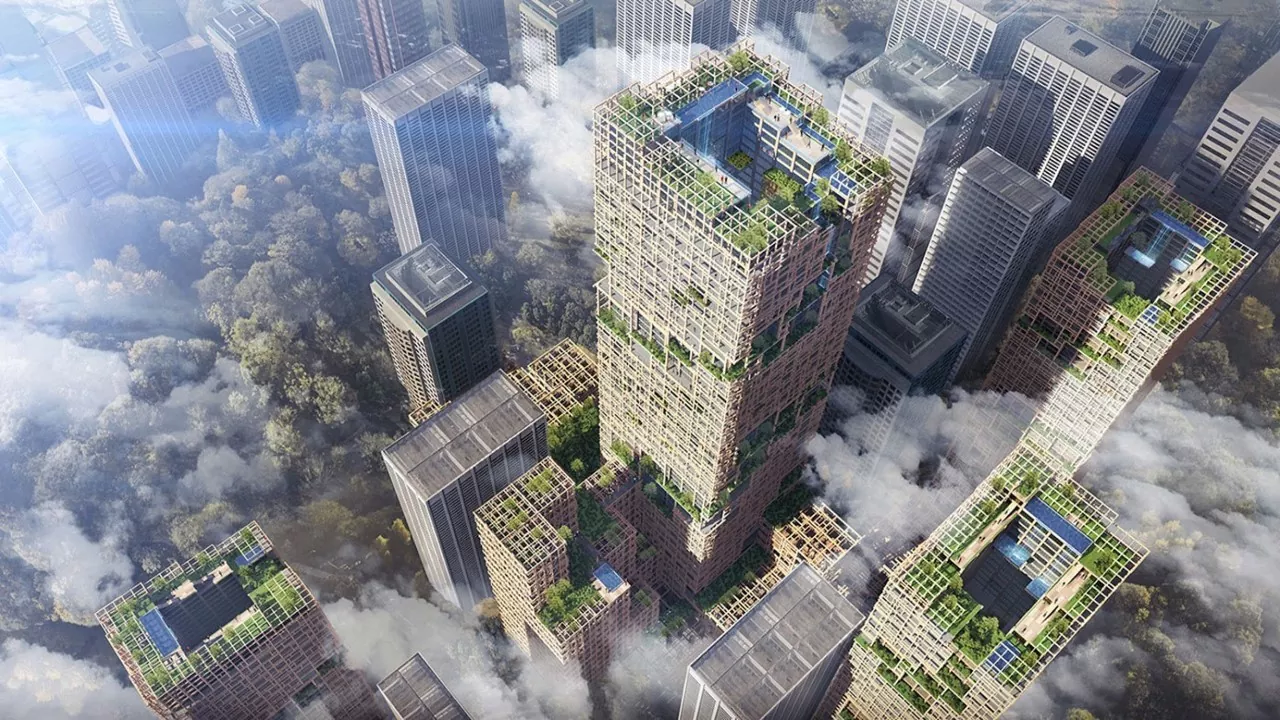
(Source: Deezen)
Solid vs Wooden Construction ? In one of our recent articles, we highlighted how Real Estate and Construction are affected by major technological changes. In this article, we focus on one of the most crucial questions in real estate that is as old as the industry itself: What’s the better way to build a house — with a solid structure made of brick or concrete, or a light construction method using wood?
With labour shortages in the US and Europe, stagnating construction productivity rates and stricter environmental regulations affecting the industry, it is as important as ever for investors and builders to ask themselves this question and choose the right material for their project.
A Brief History
There are two different ways to build a house:
(1) The solid construction method with clay, bricks or concrete blocks versus
(2) Wooden construction, where a house is built from (prefabricated) wooden panels (timber).
In regions abundant with forests like the US and Europe, wood was the dominant construction material for thousands of years. However, it is also a highly inflammable material, which used to make timber buildings more susceptible to fires. When industrialisation brought advances in concrete and steel construction, wood went out of vogue and gave way to solid construction in the 19th and early 20th century. Since the middle of the last century however, we are seeing wooden construction on the rise once again, because significant improvements in fireproofing and insulation have made timber houses viable competitors to the solid construction method. In recent years, sustainability aspects also added to the revival of wood as a building material.
So what makes these two methods different? What should builders look at when considering their options? We took an in-depth look at how the two methods compare across the lifecycle of residential homes.

(Source: SABMag)
Solid vs Wooden Construction: Cost
Contrary to a widespread belief that the material price of wood is cheaper than concrete, it turns out that the final price tag of a comparable brick, concrete or wood building doesn’t differ much. One reason for this is that many elements of the project such as land purchase, digging, piping or electricity remain the same, no matter the material. A detailed study of the German market found wooden homes to be 4% more expensive than solid buildings, while in the American multi-family market, wooden buildings are said to be slightly cheaper. Bottom line: the highly diversified design of homes, complex variables such as location or labor and fluctuating material prices make it very difficult to give a conclusive answer on which material is cheaper than the other.
Solid vs Wooden Construction: Construction
Where wood comes out on top, however, it is in the speed of construction. Components of wooden buildings are prefabricated in a factory and can be quickly assembled at the location, allowing for a faster and easier buildup that can be up to 20–30% quicker than for solid houses. Offsite construction companies have traditionally been local players, but startups like Silicon Valley-based Katerra — which raised $700 million from Softbank in 2018 — are setting out to disrupt the global construction market by offering full vertical integration of design and construction.
Timber is also lighter than bricks or concrete, making it easier to transport. Developers building with wood therefore can expect to receive rental income sooner and have more confidence when it comes to meeting project deadlines.
Safety
One of the oldest concerns around building with wood is that it is more flammable than other materials. There have indeed been several high-profile news stories about wooden buildings catching fire in the US and the UK. But it is important to note that these incidents happen not when the building is occupied, but during construction when no sprinklers, drywalls or fire separations are built in. A finished wooden building meets the strictest fire safety standards, but builders (especially of larger projects) need to be wary that all safety precautions are met during the construction phase as well.
Structural Performance & Durability
Another misconception in the real estate industry is that wooden buildings have a shorter lifespan than solid houses. However, this is not the reality. Both wooden and concrete buildings tend to last for well over 100 years and show no measurable differences in their durability.
Until recently, timber buildings in both in the US and Europe could only be constructed a few floors high, limited by regulations such as the International Building Code (IBC). Advances in the last two decades, such as the invention of cross laminated timber (CLT), now make it possible to safely construct mid-rise and even high-rise buildings with wooden walls. As of 2015, wooden buildings in the US can only be up to six floors high, but a new regulation is set to enter into force in 2021, allowing them to be up to 18 floors high. In other countries, this is already possible: The world’s highest timber tower stands in Norway at 85 metres and there are plans to build wooden towers over 300 metres high — such the Oakwood Tower in London, or a 350-meter-tower project in Tokyo that would be the tallest Japanese skyscraper.

At 85m, Mjøstårnet in Norway is the world’s tallest timber building (Source: Moelven)
Solid vs Wooden Construction: Sustainability & Energy-Efficiency
Buildings account for more than a third of the world’s energy use and CO2 emissions. This is mainly due to the use of concrete, the second most used material in the world after water. It is actually cement, one of the ingredients of concrete, that is responsible for most of these emissions. If the cement industry were a country, it would be the third biggest polluter in the world. Some of these emissions are mitigated during the lifecycle of a building as concrete stores CO2 in a process called carbonisation, but it is not nearly enough to offset the heavy environmental impact of concrete in construction.
On the other hand, wood is a carbon-neutral element that binds carbon extracted from the atmosphere. Especially when sourced from sustainably managed and regrowing forests (as indicated by the FSC label), wood has the least environmental impact among all materials. A study by CORRIM (Consortium for Research on Renewable Industrial Materials) found that concrete buildings create between 26% to 31% more carbon emissions over their life cycle than wooden buildings.
Solid vs Wooden Construction: Reusability
The last step in the building lifecycle is the demolition and subsequent recycling of components. The good news here is that most building materials can be used after demolition. For instance, concrete can be turned into mortar or be crushed into gravel for road construction. Wood too can be reused in new buildings or get up-cycled into more valuable products like furniture, while bricks have a lifespan of more than 200 years and can be reclaimed for new construction as well. There is a growing industry around creating entire homes from recycled materials, with companies like StoneCycling from the Netherlands collecting waste from old buildings and turning it into high-quality new building materials. The most important thing for builders that are sustainability-minded to consider is that upcycling of old materials is always better than down-cycling.

A Dutch home made of recycled bricks (Source: StoneCycling)
Solid vs Wooden Construction: Financing & Insurance
There are now plenty of mortgage lenders available for owners to finance their timber home in Europe and the US, but when it comes to the rates of financing and insuring the property, differences between the two construction methods will vary across markets.
In countries with a strong share of wooden homes, such as Sweden and Germany, there are no observable differences in mortgage and insurance rates between the two methods, with big insurance providers stating that they do not take the main building material into consideration. In other markets such as the US, there may be some disadvantages for those wanting to build with wood, because certain mortgage lenders categorize wooden buildings as non-standard buildings with a perceived increased fire risk. We will cover the topic of financing across different construction methods in more depth in a future post.
BFP’s View on Solid vs Wooden Construction:
With regulations worldwide allowing for increasingly tall buildings made of timber, a growing emphasis of consumers on sustainability and the fact that sustainable buildings can be sold at premium prices, we expect wood to continue to increase its global market share in the future. This growth will especially be seen in the multi-family market, where concrete and steel have been the only viable option until recently.
The main obstacle to this change is the industry itself. Many builders have traditionally invested in solid construction and may be reluctant or unable to try new methods. Timber construction requires completely different skills and equipments and a highly fragmented and competitive industry with low margins implies that traditional construction companies may have a hard time changing their methods. Still, we believe that the time and technology is right for many developers to seriously consider wood as a more sustainable and easy building material for their project.
Sources:
Allplan — Solid construction — The German’s favorite construction method
ARGE — Massiv- und Holzbau bei Wohngebäuden
BCG — Building the Housing of the Future
CORRIM — Life-Cycle Environmental Performance of Renewable Building Materials
Economist — Why more buildings should be made of wood
Guardian — Ply in the sky: the new materials to take us beyond concrete
Institut für Bauforschung e.V. — STUDIE ZUM KOSTENVERGLEICH: MASSIVHAUS / HOLZFERTIGHAUS
JLL — Measuring the value of sustainable real estate investment
McKinsey — Strategy in the face of disruption: A way forward for the North American building-products industry
Scielo — Life cycle assessment of building construction materials: case study for a housing complex
Sustainability — Does Sustainability Affect Real Estate Market Values? Empirical Evidence from the Office Buildings Market in Milan (Italy)








